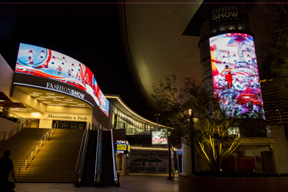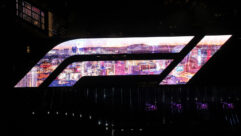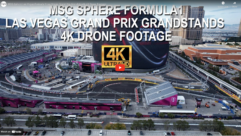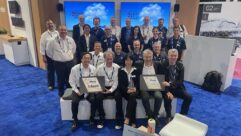
SVC Podcast – Show Notes – Show 146-1:
In this edition of the SVC Podcast, SVC Contributing Editor Bennett Liles talks with Jim Vasgaard and Ed Wasserman of Daktronics about the new LED video capable displays lighting up the plaza at Fashion Show Las Vegas. Their work includes LED video columns, billboard and marquee pylon displays. Covering a combined 10,000 square feet and reaching 112 feet at its tallest point, the new signs feature new Daktronics LED technology to enable them to stand out even in the harsh desert sun. Jim and Ed discuss building and transporting the new signs from Daktronics in South Dakota to Las Vegas and the massive installation project.
For Part 2
Links of interest:
- Daktronics, maker of the world’s most spectacular signage
- Fashion Show Mall Las Vegas
- Daktronics Precision LED Technology
Download Podcast Here:
https://s3.amazonaws.com/nb-svc/public/public/146-1_Daktronics_Fashion_S…
From Sound & Video Contractor Magazine, this is the SVC Podcast with Josh Howardson and Jim Vasgaard of Daktronics. Show notes for the podcast are available on the web site of Sound & Video Contractor Magazine at svconline.com.
They call it The Cloud but it looks more like a huge flying saucer hovering over the Fashion Show Mall in Las Vegas. Daktronics got the job of outfitting it with new LED video displays. These had to compete with signs on the strip at night and the desert sun during the day. Jim Vasgaard and Josh Howardson are here to tell us how Daktronics got it all up and running coming right up on the SVC Podcast.
Jim and Josh from Daktronics, welcome to the SVC Podcast. The Fashion Show Mall on the Las Vegas strip got a big facelift with new LED video displays. You two were right in the middle of this project but before we get into that, Jim Vasgaard, tell us about what you do at Daktronics.
Jim: My responsibility is I’m the National Sales Manager for Spectacular Projects. That’s basically any large, unique video systems in non-sporting venues in the U.S. and Canada.
Well, that’s a very interesting job title.
Jim: It’s kind of fun to be able to say you work on spectacular projects.
Yeah, officially. And Josh what do you do for Daktronics?
Josh: I’m an application engineer, which just means that I work with the customer and Daktronics engineering to kind of help the customer figure out what they want to do and how we use Daktronics to solve those problems. [Timestamp: 1:42]
This signage project is right on the Strip in Las Vegas, quite a job just getting something to stand out and get attention along that street. That massive job doesn’t just come up overnight so Jim, how did this project sort of evolve for Daktronics. How did it come about?
Jim: This is a project that’s driven by GGP. They’re a large mall developer that own the Fashion Show Mall. We’ve done quite a bit of work with them at numerous properties all across the country; interior signage, exterior signage. And so they actually talked to several different companies in the industry about reimaging their property. It needed a little bit of a facelift. There’s a lot of properties around the Fashion Show Mall that had grown up, expanded, done different things with signage, and they just really needed a facelift to become relevant and very much more apparent on the Strip. So they worked with some different companies, and Ed Wasserman, our salesperson, and Deb Howard, who leads our sign design group, actually spent a lot of time working with them looking at properties and came back with some different design ideas that integrated some of the uniqueness of the properties, provided large digital canvasses that they can use to promote themselves and do some other advertising sales and promotion on. And really just become a much more visible and dynamic property there on the Strip. [Timestamp: 3:02]
You have to call in the big guys for something like this and they look at your track record so where else have you done the more spectacular jobs like this recently?
Jim: Well, gosh, if you look at just domestic applications we’ve done a lot of work in Las Vegas. We just did all of the new interior and exterior signage for SLS Casino, which is on the north end of the Strip there. We recently did some signage upgrades for Treasure Island, which is a few hundred feet down the road from Fashion Show. But you know, we’ve done a lot of work out in Las Vegas. South Point Casino Group has been a long-time customer. We’ve been doing products there for 9 or 10 years. Between outdoor signage, interior signage, displays in arenas, I think we’ve got around 21 or 22 displays just on the property there at South Point. We’ve done just about all the work at Venetian and Palazzo. Again, they’re another long-term customer. Even going way back in time we did the first large four-color display system with colored lightbulbs at Cesar’s Palace back in the early 80’s. So we’ve got a long history in Las Vegas. We do a lot of work in New York City in Times Square. We just updated the Morgan Stanley site, which actually was about 20 years old and we were able to keep it that long. We just updated them to a full-color system. New signage at J.P. Morgan Chase, Revlon, 9 Times Square, the exterior signage at Madison Square Garden. All told, we’ve installed about 37,000 square feet of digital display in and around Times Square in about the last 13-14 months. And then as we mentioned, a lot of mall customers all across the country. We’re an international company. We’ve done some significant display systems in Asia and Europe and the Middle East. So there’s a lot of examples we can point people to when they want to see what’s possible. [Timestamp: 4:57]
Let’s talk about the major components of this thing. Not just one big exhibit, but there were wrap-around column displays, billboard screens, marquee pylon displays and I think there were some improvements to existing signage. So what all did you have on your plate for this?
Jim: Well, we integrated, as you mentioned, some pylon displays. We actually wrapped some existing pylons. The south pylon there at the property is around 58 feet tall and overall 80 feet long as it wraps around the pole. And then the north pylon is a little bit smaller. That’s only about 42 feet tall by 80 feet long. But what’s interesting is even those sizes we’re able to do full HD or high definition matrixes. So you can use HD content and it looks truly, truly amazing. Then we did a 14’ x 112’ display at the entrance above Neiman Marcus and that’s got a unique curve to it. We then did some 8 mm displays that are down at the street level on the north and south ends. And then we upgraded some of their interior video signage that they’ve used – if you’ve ever been in the Fashion Show Mall they actually have a fashion runway they use for different events and promotions kind of in a courtyard. We updated that display to a tight 6 mm resolution product that they can use for advertising, promotion, and live events as well. [Timestamp: 6:25]
Is that the one that’s the three-screen video display right over the runway in the Fashion Show’s Great Hall?
Jim: Yes, it is. We filled up the entire area that was about 39 feet long, and those were about six feet tall, but they had them split into thirds. So basically they had about three displays that were around 6’ x 13’. We upgraded and went 10’ x 13’ wide so they had a good aspect ratio for live content ads, but they kept them split because they actually have each display on a hoist so they can move them up and down in position behind the fashion show or behind some type of live entertainment that they may have in that central area in the mall. [Timestamp: 7:08]
The first thing you notice when you walk up to the Fashion Show Mall is what they call The Cloud and it looks like a huge aluminum spaceship just hovering over the place as if it were about to slide down the two big columns and land. With all the curved surfaces and extreme angles it must have been a big consideration just to nail down all the sight lines and exactly what you can see from where.
Jim: Yes. That really was important, those lines that Ed and Deb and the team really took a look at. That’s why you have a little different sizes on the pole wraps, to maximize the visibility from various points coming up and down the strip and the different properties across the street. That curved entrance sign, that is also highly visible from down the strip as well as if you’re coming westbound on the street that runs by the south end of the property. So yeah, there was really a lot of time spent taking a look at how do we position the displays, what’s the optimal curve and shape. And then we also worked with them to put some new identification signage up above the saucer – the flying saucer, if you will – so that the name of the property is very visible from both ends of the people coming south on the Strip as well as progressing north up the strip as well. It’s really important to give them some name recognition, update the signage so that you could tell what the property was, and then just give them a real dynamic digital display system. [Timestamp: 8:29]
And who were the nuts-and-bolts guys on this one? Who actually did the installation of the displays?
Jim: We worked with a local company called Vision Sign. They’ve done a lot of work. They’ve been in Vegas for many years. And that’s what we do when we work in a community on a project of this type. We work with local companies. We want to invest in the community. They know the area and they know the codes and understand the work requirements really well. So it’s important for us to find a good local company to work with. [Timestamp: 8:59]
Yeah, just sorting through all the building codes and whose sign might block someone else’s from what direction, a local outfit would be much more familiar with all of that. But these weren’t built onsite. Didn’t you build them at Daktronics and then ship everything to the site for assembly?
Jim: Yeah. That’s one thing that Daktronics is a U.S. manufacturer. We do all of our module construction. We buy components and we load all the LED’s into the circuit boards, make all the modules here, calibrate them, and then assemble into display sections. But to make it more efficient to handle, easier to install so you don’t have a lot of seams, we do build in smaller sections. We’re not looking to ship big, boxcar-sized displays. We ship small sections out and then Vision actually fit the display together in their yard. And then knowing what size sections would be easier to handle and work with at the property, they then disassembled it and then put it together and fit it around the poles and pylons at the property. Because one of the challenges was the plaza that these displays are mounted on, there’s restaurants and walkways, but there’s actually a parking garage underneath the plaza. So you had to be very cognizant of weight load distribution and weight load requirements. So it’s not like you want to have great big pieces of equipment working out there. You’ve got to work around a construction site and work around some of the limits of the property as well. [Timestamp: 10:25]
I would think there’s no low-traffic time on the Strip. It’s going full blast twenty-four hours a day. So was that any kind of problem just keeping traffic out from under your work during the construction?
Jim: Well, they had really planned ahead because they were renovating the property, adding in some new restaurants and bringing out storefronts. So a good part of the plaza was really closed for a lot of this work. They were very cognizant of keeping people out the way and safety issues. But it was both a sign construction zone as well as mall construction zone as they renovated the plaza and the storefronts out there. [Timestamp: 10:58]
And we’ll be getting into more detail on this in Part 2, but the video displays are easy to see at night. In the glaring desert sun during the day, it’s got to be a lot more difficult to make them stand out. What sort of LED technology did Daktronics use to do that?
Jim: We really have to be cognizant of how to compete with the sun and provide good contrast so that at any time of the day these displays are very vibrant. But you also have to be very cognizant of the viewing angles and especially people in the plaza walking by the property. You want them to be able to look up and see the display for as much length of time as possible. So we utilized our surface mount technology. The pole wraps and the entrance sign are 15 mm displays. But one of the things that our engineers have worked very hard to do is when you look at our displays, and we’ve heard comments from other venues around there, our display has got a very rich black surface, so you’ve got very good contrast. But the other thing that we do is, like a lot of other companies, we have louvres on the display to create a little bit of a shadowbox to keep some light from shining directly onto the LED itself. But to maximize the viewing angles, we’ve come up with a unique design we called our city-view louvre, where we angle the louvre a little bit and tuck the LED underneath it so that we can shorten the louvre so we’ve got really good downward viewing angles but yet still keep the sun off of the LED and give you really good contrast. So the images are very vibrant, the content is really amazing out there, so the displays really capture your attention and you feel like you’re looking at a big screen TV, whether it’s in the daylight or at night. [Timestamp: 12:39]
Vastly different signage environment between day and night on that incredibly busy street. Loved hearing about how you tackled that. Jim Vasgaard and Josh Howardson from Daktronics and the Las Vegas Fashion Show Mall LED video project. Thanks for telling us about it and we’ll see you in Part 2.
Thank you for being here with us for the SVC Podcast with Jim Vasgaard and Josh Howardson from Daktronics. Show notes are available on the web site of Sound & Video Contractor Magazine at svconline.com. Be back with us next week for Part 2 when we’ll go further into the technical aspects of the new LED video displays at Fashion Show Mall in Las Vegas. That’s on the next SVC Podcast.










